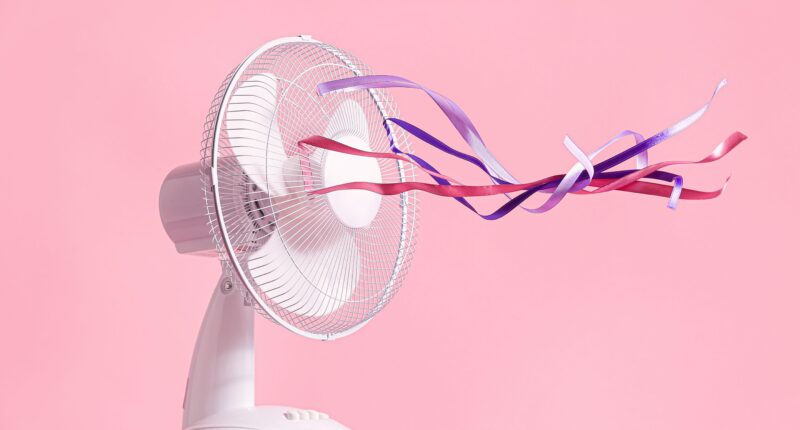THE weather is really starting to heat up and more of us will be digging out our electric fans to try to keep cool.
But did you know that the location and position of the gadget could add to your energy bill? We reveal the simple mistakes you could be making.
It might be tempting to keep your fan on for extended periods of time, especially during the night, this could be a mistake.
Plus, with rising prices hitting households and energy bills still a big concern – everyone is looking to save where they can.
We’ve looked at common mistakes people make when using a fan, so your bills don’t suffer.
From the more obvious to the lesser known, here are the simple mistakes and how to fix them.


You have it in the wrong place
You could actually be wasting your hard-earned money because your electric fan is in the wrong place.
We spoke to energy expert Nicholas Auckland at Trade Radiators who revealed where you put it and the direction its facing will impact your bills.
He said: “Having a fan pointing into the corner or the wall of a room is probably one of the main ways people can waste money when using their electric fan.
“The electric fan just circulates air instead of actually producing any cool air itself, so it’s important that the fan is pointing in the right direction and circulating the right air.”
Most read in Money
Nicholas said that for that reason you should think about placing your fan in the centre of a room or facing inwards from the corner.
“If you have your fan in the wrong place where it isn’t making the air feel any cooler, then you’d be looking at wasting around 16p for every 12 hours it’s on,” he added.
Not slowing your fan down enough
This mistake might sound pretty obvious, but the faster your fan is going, the more energy it’s using.
That means the best way to save energy with a fan is to turn it down to a lower setting.
But make sure you’re picking a speed that gives you a decent breeze at the same time.
Before you go and buy a fan, you might like to test out the different speeds to see if the lower ones can still keep you cool.
Remember, when you are out shopping for a fan, the most expensive model might not be the best.
It pays to compare prices, use platforms like Google Shopping and PriceSpy to find the best deals.
Closing your windows
As Nicholas mentioned, fans don’t actually cool air down – they just make you feel cooler.
The air moving over your skin can lower your body temperature but won’t do much about the heat inside a room – especially if you have the windows in the room closed.
But a nifty trick could make your fan more like an air conditioner.
If you place your fan in front of an open window it can improve its cooling effect.
Although if it’s an especially hot day, this could mean blowing warm air right at you, in that case why not place a bowl of ice cubes in front of the fan to get a nice breeze.
Of course it’s important to remember that if you don’t plan on being in the room there’s no point of leaving the fan on as it won’t do anything to the heat inside the room itself.
That way you’re not wasting more energy.
Not giving your fan a good clean
As the temperature rises you might find yourself searching desperately in the loft or shed for an old fan.
You might find that when you fish it out its got a layer of dust across its blades too.
That’s why it’s important to make sure it’s clean and that the mechanism is in good working order.
This is because the dust can reduce the efficiency of the mechanism.
Plus as a bonus it means your fan won’t be blowing the dirt around your room and potentially getting you all bunged up.
If you don’t let your fan do its thing
Another simple mistake you might not have thought of is keeping your fan aiming in one direction.
Oscillation fans that oscillate (move from side to side) the most efficient model you can get.
This is because they move air around a whole room, rather than just cooling down one specific spot.
So, while it may be tempting to have the gadget just aiming at your if you’re feeling a bit warm, it’s better to let it turn from left to right.
The good news is that most fans, even the cheapest ones, should have this feature.
So if you are buying a new fan, make sure it oscillates and make sure to keep it on this setting.
How much energy does a fan use?
Exactly how much energy your electric fan uses depends on which make and model you have.
If you’d like to find out how much electricity your fan uses, you first need to work out its “wattage”.
Finding this out will give you the answer and tell you the amount of power it’s using.
Then you need to find the total output you will have to turn that wattage into kilowatt hours.
There’s a bit of maths involved as first you divide the kilowatt hours by 1,000.
This will give you how much output is used in one hour.


So if your fan is 70 watts output on its high setting and you always use this, divide 70 by 1000 = 0.07.
Then multiply this number by the number of hours you’ve used the fan. For example, if you’re using it for 12 hours at a time, then 0.07kW x 12 hours will mean 0.84kW output.
Do you have a money problem that needs sorting? Get in touch by emailing [email protected]









